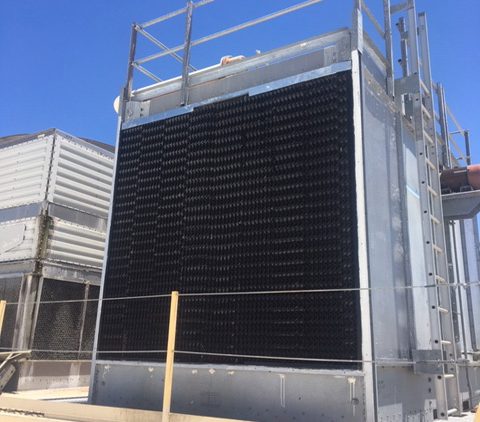Difference Between A Cooling Tower And Chiller
If you’re looking for the difference between a cooling tower this post is for you. While both play an important role in commercial buildings or industrial processes they do have different jobs to fulfill and work together.
What is the difference?
Both cooling towers and chillers are designed to remove heat from liquids. The liquids are used to cool industrial processes like power stations or in HVAC applications in large commercial buildings. Both of these pieces of equipment vary depending on their role in a setting, which components they are comprised of, and the type of equipment they power and keep cool.
Chillers
Chillers differ in that they absorb heat from the coolant, which is usually fully contained within the cooling system. The chiller transfers the heat to the surrounding air.
Cooling Towers
A condenser discharges water to cooling towers that then removes the heat. This is done via air liquid contact by spraying water onto surfaces with fans blowing air through the tower. By doing this the heat in the liquid is transferred to the air passing through the tower.
Cooling Tower & Chiller Types
Cooling Towers are divided into to types which are natural draft and mechanical draft. Natural draft cooling towers are enormous structures commonly associated with nuclear power plants where the exhaust air is let into a tall chimney. As the air rises it begins to cool naturally Mechanical draft cooling towers differ in that they use fans to pull cool air from outside into the system to transfer the heat from the liquid. Chillers are much like radiators and can be cooled by air or water. Water cooled chillers may need more maintenance than air cooled chillers, yet they use much less power.
Cooling Tower & Chiller Major Components
Cooling towers major components include the pumps and basin. The pumps send the water to the cooling towers which creates the cooling flow that cools the facility. Distribution basins collect discharge water from the coolant circulation system.
Chillers consist of compressors, condenser heat exchangers, and evaporator heat exchangers. The component in a chiller that rejects the majority of the heat to the air is the condenser heat exchanger.
Uses & Applications
Chillers are used in areas which will not be affected by the additional heat discharged by it. In fact many installations rely on the chiller to produce heat during the cooler months. Typically facilities to find chillers in include refrigeration and plastic industries.
Cooling towers are found commonly in mechanical processes and electric power generation. Power plants are commonly located near lakes or rivers which are tapped to provide cooling to the water circulating in the system. The water coming out of the condenser in these plants must be cooled to sustain the process.
Efficient Power Consumption
Chillers use compressors and heat exchangers to cool and are not as energy efficient as cooling towers. While the fans and water pumps in cooling towers do consume energy they also provide much greater cooling capacity.
Chillers which use air cooling are also not as efficient as water cooling chillers. We all know that a wet surface transfers heat better than one that is dry. The same principle applies in the case of chillers with a 10% greater efficiency in water cooled chiller units.
Phoenix Valley Chiller & Cooling Tower Maintenance
If you need chiller maintenance or cooling tower maintenance to get the most of your equipment All Kote Lining Inc. is here to help. We can maintain your equipment so it is more efficient and lasts longer. That means you save money as it operates and won’t have to spend money replacing it as soon. Our services are through and can be ordered on a regular basis to ensure your equipment stays in top notch condition.
Call Today – 480-966-4446

